Carpet beetles are commonly confused with bed bugs.
That’s no surprise as both are tiny and harbor in furniture, blankets, carpets, and other household items.
Nonetheless, correctly identifying these two pests is vital to terminate them.
In this article, we’ll go over all the differences between carpenter beetles and bed bugs.
Let’s dive in.
Carpet Beetle Vs Bed Bugs: Appearance
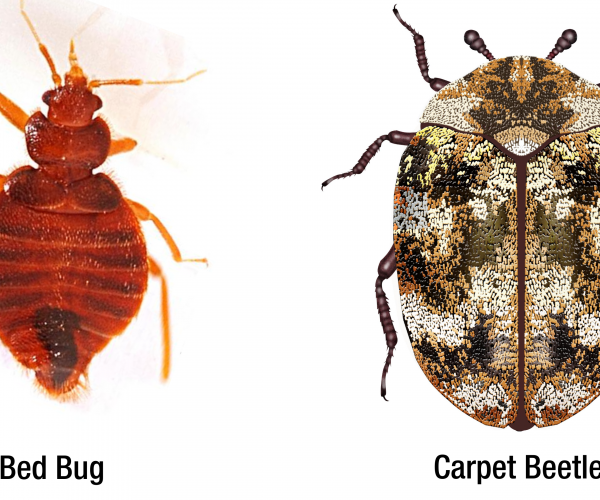
- Bed bugs are around 3/16 of an inch (4 to 5 mm). They are comparable in size to short-grain rice. Adult carpet beetles range from 1/16 to 3/16 of an inch (2 to 5 mm).
- Bed bugs have an oval shape and are typically flat before drinking human blood. Similar to bed bugs, carpet beetles take on an oval flat-shaped appearance.
- Bed bugs have colors ranging from light brown to dark brown. The Common Carpet Beetle and the Varied Carpet Beetle have patterns with multicolored scales. The Black Carpet Beetle is uniformly black and has an elongated body.
- Bed bugs have six legs with four facing backward and two facing forwards. Carpet beetles have 6 short legs.
- Bed bugs characterized by their diagonal antenna. Carpet beetles have two bent antennae.
- Bed bugs do not have wings and cannot fly. In contrast, carpet beetles develop fully functional wings and can fly.
Bed Bug vs. Carpet Beetle: Distribution
Bed Bugs
Bed bugs are found across the United States, including Alaska and Hawaii.
They are particularly common in large cities where housing is closer together.
Bed bugs are also commonly found in apartments, public transportation, schools, nursing homes, and retail stores.
Carpet Beetles
Similar to bed bugs, carpet beetles are found across the U.S, including Alaska and Hawaii.
Bed Bug vs. Carpet Beetle: Habitat
Where Do Bed Bugs Live?
Bed bugs feed on humans and prefer to live near their host. They typically aggregate in cracks, seams, folds in fabric, and small crevices.
Bed bugs flourish in places where humans stay for long periods.
As such, they are most often found in mattresses, box springs, headboards, nightstands, pillows, and other furniture in bedrooms.
They are also commonly found in living rooms and home offices.
Bed bugs can live on nearly any fabric. They can also survive on hard surfaces such as wood and plastic.
Where Do Carpet Beetles Live?
Carpet beetles can live both indoors and outdoors.
They are common in gardens and yards. You can typically find carpet beetles near flowers, trees, or bushes.
Carpenter beetles also like to be near animal-based items, including carpets, upholstery, blankets, coats, comforters, clothing, pillows, wool, and silk.
Larvae avoid the light and seek out dark areas to live and hide.
Adult carpet beetles are attracted to light and often enter your home by flying towards the light from windows and doors.
Bed Bugs vs. Carpet Beetles: Bites
Do Bed Bugs Bite?
Yes. Bed bugs bite humans to feed on blood.
When bed bugs bite you, they administer an anesthetic, to make it painless. This method allows them to suck your blood without you noticing.
They also release anticoagulants so they can feed on your blood as efficiently as possible.
But while bed bug bites are not painful at first, they can eventually become swollen and irritated.
Bed bug bites look like welts and do not have a red spot at the center, unlike other insect bites such as spiders and fleas.
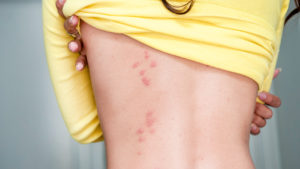
Do Carpet Beetles Bite?
Carpet beetles don’t bite people.
Some people are allergic to carpet beetles, and they can cause allergic reactions that may look like bug bites.
These allergic reactions are often perceived as bites from carpet beetles, but they not.
Unlike bed bugs, carpet beetles do not survive off blood; instead, they eat animal-based products such as wool. They also commonly survive on plants and pollen outdoors.
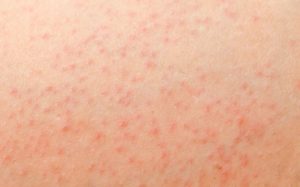
Bed Bugs vs. Carpet Beetles: diet
What Do Bed Bugs Eat?
Bed bugs rely solely on blood to survive.
They will suck on the people or pets in the home they are infesting.
What Do Carpet Bugs Eat?
Carpet Beetles eat pollen and plants.
They will also eat any animal-related fabrics such as wool, blankets, clothing, and upholstery.
Bed Bugs vs. Carpet Beetles: Flight
Do Bed Bugs Fly?
While adult bed bugs develop wing pads, they do not fly.
Theses wing pads do not develop into fully functional wings and have no practical use.
Do Carpenter Beetles Fly?
Unlike bed bugs, Carpenter Beetles can fly.
They can often fly into homes through open windows and doors or other small crevices.
Carpet beetles will fly to enter your home, when in search of food, or search for new breeding areas
Bed Bugs vs. Carpet Beetles: Dangers
Are Bed Bugs Harmful?
Bed bugs do not carry any diseases and are relatively harmless compared to other pests such as mosquitoes and cockroaches.
That said, having a bed bug infestation can be disruptive to the well being of their human host.
Most people that have infestation suffer from anxiety and lack of sleep.
Bed bug bites can cause discomfort, itchiness, swelling, and in rare cases, anaphylaxis.
Bed bugs shed skin to grow. These skin casings can cause and allergic reaction to some.
Finally, while they do not transmit any diseases, they are capable of transmitting a parasite.
Research shows that bed bugs are capable of transmitting the parasite Trypanosoma cruzi which causes Chagas disease.
Although, these situations are highly uncommon and there are no documented cases it is possible for bed bugs to do so.
Are Carpet Beetles Harmful?
Carpet Beetles can be harmful to your health.
They can cause severe allergic reactions known as carpet beetle dermatitis.
Carpet beetle dermatitis is characterized by itchy rashes caused by the carpet beetle larva’s hair and blood.
Since carpet beetle larvae hide inside the blankets, clothes, and furniture it’s easy to come in contact with their hair and blood.
Airborne fibers from Carpet Beetles can also cause respiratory tract issues.
Carpet beetles are also destructive pests.
These beetles and their larvae feed on a wide range of household fabrics such as blankets, upholstery, and clothing.
Bed Bugs vs. Carpet Beetles: Babies
What Do Baby Bed Bugs Look Like?
Bed bugs go through a partial metamorphosis, which means their babies look similar to adults.
Baby bed bugs, or nymphs, go into five stages before becoming a full adult.
When bed bugs first hatch, they are only about 1.5 mm long. They have white, oval, and flat bodies.
The nymphs also have two antennas and six legs.
As they mature, they gradually turn from white to dark brown.
Nymphs shed their skins to grow in a process called molting. Every time they molt, they become slightly darker and bigger.
Baby bed bugs need to feed on blood to grow. If they can find enough food, they can become full adults in about six weeks.
They can grow up to 4.5mm long before shedding their exoskeletons one last time.
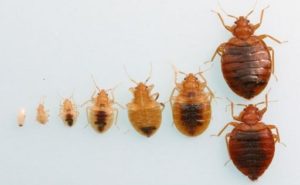
What Do Baby Carpet Beetles Larvae Look Like?
Carpet Beetles go through full metamorphosis, which means their babies do not look like the adults.
After Carpet Beetle eggs hatch, they turn into larvae until they are ready to become adults.
Larvae look like small fuzzy worms.
They can grow up to ¼ of an inch, have an oval shape, and have brussels or hairs on their back.
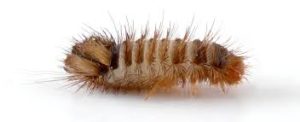
Bed Bugs vs. Carpet Beetles: Eggs
What Do Carpet Beetle Eggs Look Like?
Bed bug eggs are white. They are about 1 mm in length, similar to the size of two grains of salt.
Theses eggs are sticky and are typically in clusters inside cracks and crevices.
Bed bug eggs take about two weeks to hatch into a white baby bed bug.
Once hatched, the juvenile bed bug will leave behind its eggshell, which generally looks like white debris.
What Do Carpet Beetle Eggs Look Like?
Carpet Beetle eggs are cream or white. They are similar in size to bed bug eggs.
The eggs have an oval shape and have a visible spike at on end.
Carpet Beetle eggs are typically found near upholstery, clothing, air ducts, lint piles, or any other fabric.
Bed Bugs vs. Carpet Beetles: Lifecycle
What Is the Bed Bug Life Cycle?
Bed bugs go through seven stages of development.
Bed bugs go through 5 different stages as a nymph.
To reach the next stage, bed bugs must eat at least once and molt to grow.
Bed bugs can hatch anywhere between 6 days to 6 weeks.
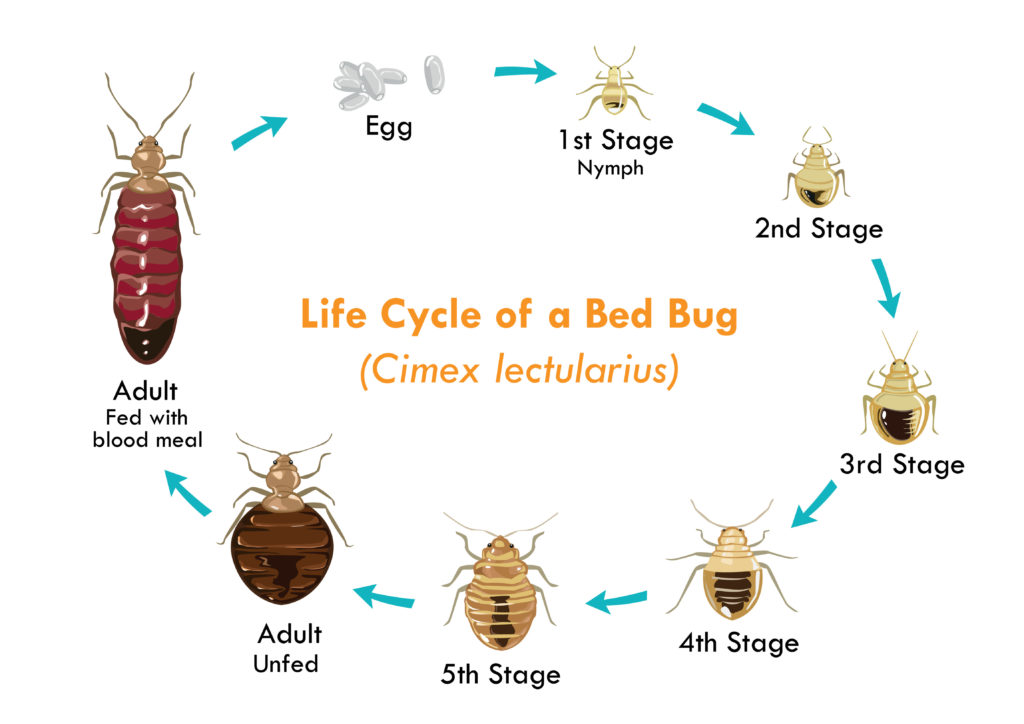
What Is the Carpet Beetle Life Cycle?
The carpet beetle goes through a partial metamorphosis.
This means that carpet beetles go through egg, pupa, larvae, and then the adult.
Eggs hatch between one and five weeks.
It can take between nine months and two years for pupae to become adults.
Adults have a very short life cycle of only 4-6 weeks.
Most of the lifecycle for the carpet beetle takes place as a pupa.
Bed Bugs vs. Carpet Beetles: Causes
What Causes Bed Bugs?
Bed bugs move from room to room through holes, cracks, and crevices.
They also enter your home by hitchhiking a ride on backpacks, luggage, clothes.
If you’ve traveled somewhere with bed bugs or have a neighbor who has bed bugs, you likely got your bed bugs there.
It’s also possible to get bed bugs if you recently purchase used furniture or other used items such as clothes.
What Causes Carpet Beetles?
Carpet beetles most likely entered your home from outdoors.
It is also possible for you to get them if you purchase clothes or furniture from a home or location with carpet beetles.
It is unlikely that carpenter beetles will hitchhike into your home from another location.
Bed Bugs vs. Carpet Beetles: Elimination
How To Get Rid of Bed Bugs?
There are several different methods that you can use to eliminate bed bugs.
The one you choose will depend on the severity of your infestation and budget for treatment.
Common treatments include:
- Washing, Steaming, and Vacuuming
- Heat Treatment
- Mattress Encasement
- Fumigation
- Bed Bug Traps
- Chemical Insecticide
How To Get Rid of Carpet Beetles?
Carpet beetles can reproduce very quickly and turn into large infestations.
Carpet beetles can hide in a variety of locations, making them quite difficult to treat.
First, identify where the primary source of the infestation is.
Carpet beetle infestations stay rather localized unless they are severe, which means if you treat the entire room, you should be able to eliminate an infestation.
To eliminate them, you will need to go through a multi-step process.
- Start by vacuuming any carpets, drapery, and furniture inside the room that is infested.
- Wash all clothes or blankets or other washable fabrics.
- Steam clean carpets, and furniture to kill any eggs.
- Use IGR and insecticide inside your homes to eliminate any remaining carpet beetles inside your home.
